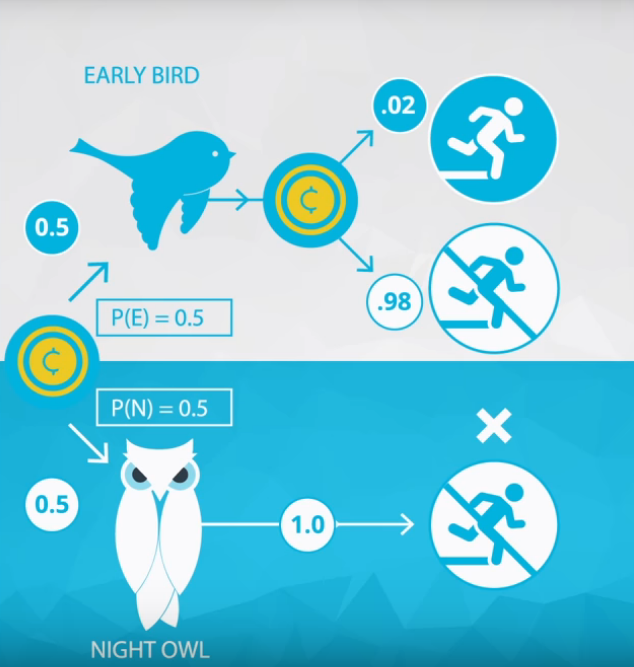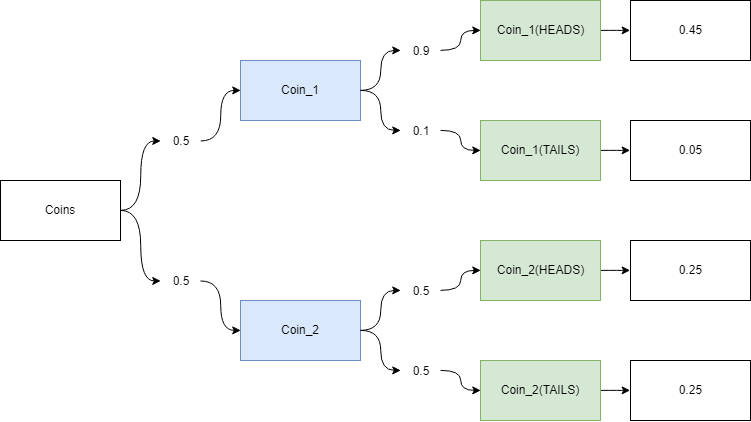4.6 Conditional Probability Lesson 06
Here the first event will affect the second one. Figure 1 shows an example of it.

Figure 1
The first event is to determine the bird type, and the second event the probability to run on the morning. Have in mind, these two birds has different probability to run on the morning.
- The early bird has 0.02;
- The night owl has 0.00.
4.6.1 Medical Example
Supose a patient with a disease, the probability of this patient has cancer is 0.9 and to be free cancer is 0.1.
\[P(cancer) = 0.1 \\ P(\neg \ cancer) = 0.9 \tag{1}\]
To be honest, we do not know if this patient has cancer, so it is necessary to apply a test. This test is not perfect, it means, there are a probability to indicates a false positive and a false negative.
For this reason, I introduce the conditional probability.
\[ P(Positive | cancer) = 0.9 \tag{2}\]
What is the meaning of this notation?
Given the patient has cancer, the probability of this test indicates positive is 0.9. Thus, given the patient has cancer and the test indicates negative is 0.1, as shown in equation (3).
\[ P(Negative | cancer) = 0.1 \tag{3}\]
Analogous to the case of the patient do not has cancer.
\[ P(Positive | \neg \ cancer) = 0.2 \\ P(Negative | \neg \ cancer) = 0.8 \tag{2} \]
Table 1 shows a representation in a tabular way.
| Disease | Test | \(P_{disease}\) | \(P_{test}\) | P | Q1: Test Positive? | Q1: Answer |
|---|---|---|---|---|---|---|
| No | Negative | \(P(\neg \ cancer) = 0.9\) | \(P(Negative\|\neg \ cancer) = 0.8\) | 0.72 | No | 0 |
| No | Positive | \(P(\neg \ cancer) = 0.9\) | \(P(Positive\|\neg \ cancer) = 0.2\) | 0.18 | Yes | 0.18 |
| Yes | Negative | \(P(cancer) = 0.1\) | \(P(Negative\| cancer) = 0.1\) | 0.01 | No | 0 |
| Yes | Positive | \(P(cancer) = 0.1\) | \(P(Positive\| cancer) = 0.9\) | 0.09 | Yes | 0.09 |
| \(\sum = 1\) | \(\sum = 0.27\) |
What is the probability the test is positive?
Q1: 0.27
4.6.1.1 Coin flip example
Two coins, one fair and other loaded.
- Coin 1: \(P_1(HEADS) = P_1(TAILS) = 0.5\);
- Coin 2: \(P_2(HEADS) = 0.9\) and \(P_2(TAILS) = 0.1\).

Figure 2
What is the probability of this sequence HEADS and TAILS?
| Coin | Flip 1 | Flip 2 | \(P_{coin}\) | \(P_{Flip 1}\) | \(P_{Flip 2}\) | P | Q2: HEADS then TAILS? | Q2: answer |
|---|---|---|---|---|---|---|---|---|
| 1 | H | H | 0.5 | 0.9 | 0.9 | 0.405 | No | 0 |
| 1 | H | T | 0.5 | 0.9 | 0.1 | 0.045 | Yes | 0.045 |
| 1 | T | H | 0.5 | 0.1 | 0.9 | 0.045 | No | 0 |
| 1 | T | T | 0.5 | 0.1 | 0.1 | 0.005 | No | 0 |
| 2 | H | H | 0.5 | 0.5 | 0.5 | 0.125 | No | 0 |
| 2 | H | T | 0.5 | 0.5 | 0.5 | 0.125 | Yes | 0.125 |
| 2 | T | H | 0.5 | 0.5 | 0.5 | 0.125 | No | 0 |
| 2 | T | T | 0.5 | 0.5 | 0.5 | 0.125 | No | 0 |
| \(\sum = 1\) | \(\sum = 0.170\) |
4.6.1.2 Summary
In this lesson you learned about conditional probability. Often events are not independent like with coin flips and dice rolling. Instead, the outcome of one event depends on an earlier event.
For example, the probability of obtaining a positive test result is dependent on whether or not you have a particular condition. If you have a condition, it is more likely that a test result is positive. We can formulate conditional probabilities for any two events in the following way:
- \(P(A|B) = \frac{P(A\text{ }\cap\text{ }B)}{P(B)}\)
- \(P(A ∩ B)\)
In this case, we could have this as:
\[P(positive|disease) = \frac{P(\text{positive }\cap\text{ disease})}{P(disease)}\]
where ∣ represents “given” and \(\cap\) represents “and”. — Class notes - Text: Summary
A work by AH Uyekita
anderson.uyekita[at]gmail.com